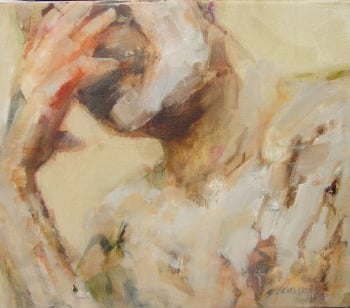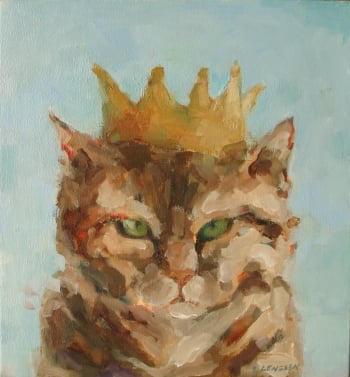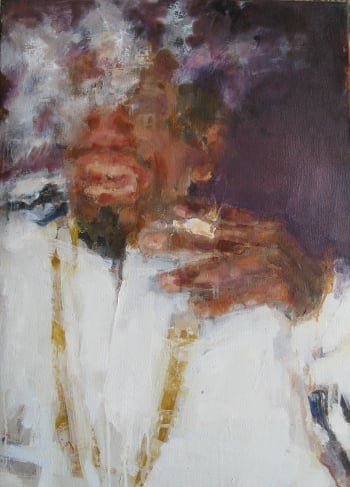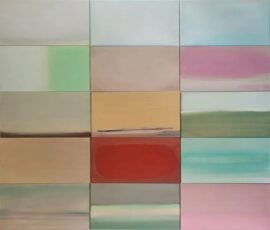From animals to inmates, artist Georganna Lenssen has an intense curiosity for her subjects. Zatista’s contributing writer Nancy Cost talks with Lenssen to discuss her mysterious and richly layered portraits, and her creative journey with each canvas.
Your work is full of movement – the strokes and gestures capture the essence of your subjects and also leave an air of mystery. Do you like the idea of your work being mysterious?
Yes. I want the work to be open-ended but retain an air of ambiguity. What the painting means to me is a very personal thing. I want the viewer to find his own way with the painting and bring his own meaning to it.
That concept of ambiguity, or secrecy, plays a strong role in your work. Can you tell us more about what this idea means to you and how it becomes part of your work?
I find both the visual language of secrecy and the concept of ‘not knowing’ very compelling. These ideas bring layer upon layer of interest to the painting.
How does African culture play a role in your work?
Secrecy is highly prized in African art. Kuba cloths, woven by African women, are beautiful in and of themselves. Another layer of interest is added when one learns that the unique variations and irregularities within the patterns are actually a coding of secrets and stories shared amongst the weavers. Only the weavers know the stories woven into the cloth. I think this concept can be paralleled in painting.
Is your work influenced by any other cultures?
Yes. I was born in Korea and have been exposed to Asian art all my life. Its reverence for nature and the vitality of its direct and spontaneous use of brush and ink have always impressed me.
How did animals become such important subject matter for you?
I just love animals and empathize so completely with them, especially cats. There’s a zen saying about how a hair’s breadth of difference can change the world. I try to make a difference by saving animals, and I can’t help but paint them.
You spend a lot of time with animals before capturing them on canvas. What are some of the ways you’ve studied them?
For a time, I painted carnivores in captivity. I painted lions, tigers, cheetahs, and, for a few years almost exclusively, African wild dogs. I became part of the African Wild Dog Behavior Committee at the Philadelphia Zoo so that I could gain frequent access to the dogs. I wanted to learn everything I could about them since familiarity with the subject breeds nuance.
You’ve also painted prisoners. How did this theme develop?
My work with carnivores in captivity evolved into an intense curiosity about humans in captivity, so incarcerated individuals became my next body of work. To me, prisoners have that same feral quality as the dogs I’ve studied. I wrote extensively to the inmates, visited them, then painted them, hoping to release something of the essence of their being into the portrait.
What is it like working with prisoners?
It is scary and compelling. You wonder why they do what they do. You get involved then you lose your sense of fear and you go further and further. I have to keep a permeable membrane.
Your portraits of prisoners are very intimate. How do you capture the essence of a person without being highly representational?
When I was working with the convicts I really tried to ‘get inside them’ before I’d paint them. I’d learn all these things once they let their guard down. I spent a lot of time writing to them and getting to know them. I’d just find something, an inexplicable quality, and connect with my impulse about them.
Tell us more about your animal subjects and your interest in African wild dogs?
The dogs are beautiful, sinewy, carnivores. The carnivores draw me because there is a dangerous quality to them, just like the prisoners. I spent days at the zoo learning what makes them tick, which eventually lead to the prisoners. The dogs’ patterning is beautiful and it is similar to people who are covered in tattoos. It’s a whole language of secrecy. It’s what they’ve gone through and what they’ve done. It’s what gangs they belong to…
How do you approach a painting?
Organically. I start with gestured lines and marks and I loosely apply pools of transparent colors. There is a magic for me in beginning a painting since it’s the origin of the story and the life of the piece. Sometimes I include text, though I know successive layers of paint will likely obliterate it. Surprising things happen. I often end up with a piece I never dreamed I’d create.
How do you achieve the rich layering effect in your work?
It’s an exploration. Marks, and mark making are essential to my work. I like to experiment with the interactions of transparencies and opacities. I often try to leave a little bit of each layer untouched as I apply successive layers. When I get lost in a painting I will intentionally create disorder so that I can start to reconstruct order again. It seems like a funny idea, but it works for me – the painting will shift into a different thing, which is usually more interesting than where it started.
You work in a highly abstracted style yet your work is not abstract. Have you ever created abstract work?
Yes, but in the long run I couldn’t stay connected. I need concrete subject matter to grab onto. As an artist, once you connect with subject matter that absorbs you it’s a highly compelling relationship between you and that subject. You always want to come back to it and explore it further – to see what else you can get from it.
Do your images tell a story?
Yes. They tell a story for me and if they tell a story to the viewer, that’s great. I paint them for myself and when someone else connects to them, it’s a huge compliment.
When starting a painting, do you have a vision of the finished work?
Sometimes. But even when I start with a specific image or idea, I’ll allow the painting to go in another direction if it wants to. The painting takes on a life of its own. I just try to let it happen.
It sounds like you are on a journey with each painting. What does that feel like?
Once you learn to connect with subject matter that absorbs you, you always want to bring it back. It is a journey. You may not go anyplace, but it’s always a discovery. I like the surprise. I love interacting with the paint.
How long does it typically take you to make a painting?
Once in a while god smiles upon me and it happens quickly, but that’s not often. Usually, a painting will morph in all sorts of ways and turn in different directions. It takes weeks.
When did you first become interested in painting?
I was very interested in art as a child. The interest has always been there.
You have an interesting education for an artist. Not many artists study economics or pursue an MBA.
I started off in art school but then I stopped. Later, I started an MBA program and as I was taking accounting courses I thought, “What am I doing?” I realized that if I was going to spend the money on school then I should do what I love. So, I went back to art school and it turned out to be the best thing for me. I went back at a better time in my life.
Have your other studies meshed with fine art?
Everything meshes together. It’s all good exercise for the brain. I think it’s all for a reason and it ends up working out the right way.
Who are some of your favorite artists?
There are so many. Favorite modern artists are: Francis Bacon, Walter Pichler, Joseph Beuys, and Cy Twombly. The old masters are always with me: Titian, Rembrandt, and Velasquez. I love Bonnard, too.
You teach a class called Direct and Spontaneous Painting. Can you tell us more about that type of painting?
It’s about exploring the visual language of paint and the sensuality of the medium. We focus less on rendering. It’s a bold and experimental approach to paint where ‘accidents’ can be viewed as opportunities.
What’s next for you and your work?
I will continue exploring urban culture and animals will play a big role in my next body of work. I’ll allow whatever else surfaces to surprise me.







I love your work…so inspiring…a new level of experience in each of your work.
Your work is very inspiring, and beautiful. I love the magic, the surprise in each painting!